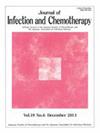Successful detection of an unrecognized outbreak of Mycobacterium tuberculosis in the modern Beijing subfamily through combined molecular epidemiological and population genetic analyses
IF 1.9
4区 医学
Q3 INFECTIOUS DISEASES
引用次数: 0
Abstract
Introduction
While multi-locus variable number tandem repeat analysis (MLVA) as molecular epidemiological analysis has been used to detect Mycobacterium tuberculosis outbreaks, its discriminatory power for identifying strains is limited. Whole-genome sequencing (WGS) offers high discriminatory power but is expensive. This study was established to develop a strategy to overcome these limitations of molecular epidemiological analysis by combining it with population genetic analysis.
Methods
MLVA data from 2732 M. tuberculosis strains isolated in Chiba Prefecture, Japan, in 2008–2016 were subjected to Bayesian population genetic analysis to subdivide the strains into subfamilies and estimate subpopulations within each subfamily. Annual changes in the number of strains within subpopulations exhibiting linkage disequilibrium (LD) in MLVA data were examined. Only strains from subpopulations displaying significant increases were analyzed by WGS.
Results
Significant LD was observed in one subpopulation using Bayesian analysis (designated P3) within the modern Beijing subfamily, which exhibited a significant increase in strain number in 2016. WGS analysis of strains belonging to P3 from 2016 revealed that 17 out of 21 of them differed by three or fewer single-nucleotide polymorphisms from their most similar strain, indicating that they had a common origin (i.e., an outbreak). Among these common-origin strains, one exhibited a four-locus variant in the MLVA, which would not be suspected of being an outbreak-related strain based on MLVA alone without Bayesian analysis.
Conclusion
The combination of Bayesian population genetic analysis with MLVA successfully detected M. tuberculosis strains from an unrecognized outbreak by performing WGS on only a subset of the strains.
结合分子流行病学和群体遗传学分析成功发现一次未被识别的北京现代结核分枝杆菌亚家族暴发
多位点可变数串联重复序列分析(MLVA)作为分子流行病学分析已被用于检测结核分枝杆菌暴发,但其鉴别菌株的能力有限。全基因组测序(WGS)具有很高的鉴别能力,但成本昂贵。本研究旨在将分子流行病学分析与群体遗传分析相结合,以克服分子流行病学分析的局限性。方法对2008-2016年在日本千叶县分离的2732株结核分枝杆菌的smlva数据进行贝叶斯群体遗传分析,将菌株细分为亚科,并估计每个亚科内的亚群。研究了MLVA数据中显示连锁不平衡(LD)的亚种群内菌株数量的年变化。WGS只分析了来自亚群的显著增加的菌株。结果在现代北京亚科中有1个亚群(P3)存在显著的遗传变异,且该亚群在2016年种群数量显著增加。对2016年属于P3的菌株进行的WGS分析显示,其中21株中有17株与最相似的菌株存在3个或更少的单核苷酸多态性差异,表明它们具有共同的起源(即爆发)。在这些共同起源的菌株中,有一株在MLVA中表现出四位点变异,如果没有贝叶斯分析,仅基于MLVA不会怀疑它是与暴发相关的菌株。结论贝叶斯群体遗传分析与MLVA相结合,仅对一小部分菌株进行WGS检测,成功检测出未被识别的结核分枝杆菌。
本文章由计算机程序翻译,如有差异,请以英文原文为准。
求助全文
约1分钟内获得全文
求助全文
来源期刊

Journal of Infection and Chemotherapy
INFECTIOUS DISEASES-PHARMACOLOGY & PHARMACY
CiteScore
4.10
自引率
4.50%
发文量
303
审稿时长
47 days
期刊介绍:
The Journal of Infection and Chemotherapy (JIC) — official journal of the Japanese Society of Chemotherapy and The Japanese Association for Infectious Diseases — welcomes original papers, laboratory or clinical, as well as case reports, notes, committee reports, surveillance and guidelines from all parts of the world on all aspects of chemotherapy, covering the pathogenesis, diagnosis, treatment, and control of infection, including treatment with anticancer drugs. Experimental studies on animal models and pharmacokinetics, and reports on epidemiology and clinical trials are particularly welcome.
 求助内容:
求助内容: 应助结果提醒方式:
应助结果提醒方式:


